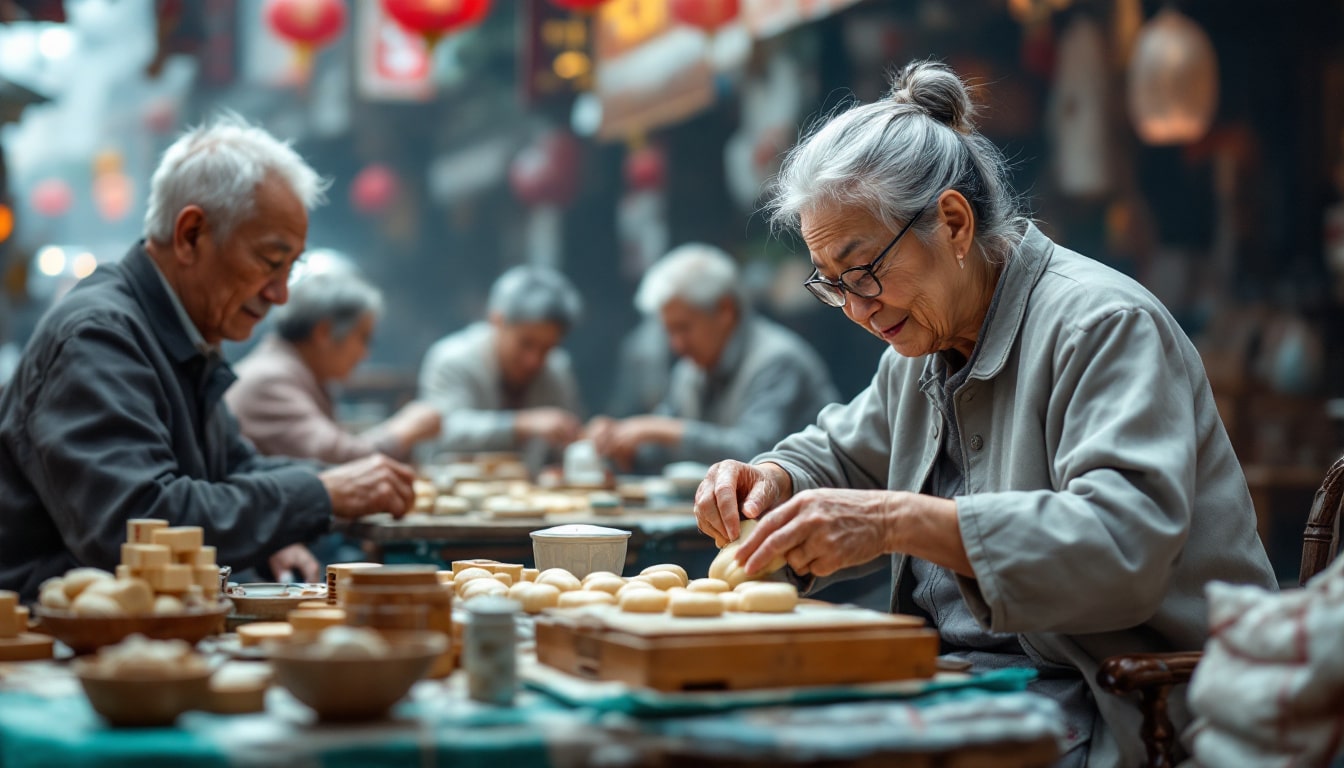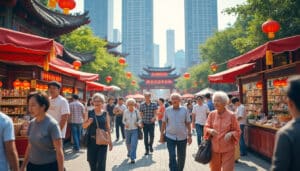The economic forecasts of China are taking an optimistic turn. ANZ analysts have revised upward their GDP estimates for 2025. This revision is based on robust industrial production and stimulating policy measures.
In 2024, China’s GDP is expected to reach 5%, reflecting one of the lowest growth rates in the last three decades. To counter current economic challenges, China is committed to injecting massive funds into its banking institutions. Meanwhile, the International Monetary Fund maintains an optimistic view by raising its growth forecasts. Additionally, the focus on the silver economy and technological innovation aims to ensure long-term stability and sustainable growth.

What is the silver economy in China?
The silver economy refers to an emerging economic sector focused on the needs and opportunities related to an aging population. In China, this trend is particularly pronounced due to the rapid increase in the number of elderly people, a consequence of decades of the one-child policy and a general improvement in healthcare. According to official data, China’s GDP reached 134.908 trillion yuan in 2024, reflecting significant growth despite demographic challenges.
This economy encompasses various sectors such as healthcare, senior-friendly tourism, assistive technology, and financial services tailored for the elderly. The importance of this economy lies in its ability to meet the growing needs of an aging population while stimulating new economic opportunities. For example, initiatives like exploring the promising potential of the silver economy demonstrate the commitment of businesses and governments to capitalize on this expanding segment.
What are the key factors driving the growth of China’s silver economy?
Several factors contribute to the rapid growth of the silver economy in China. First, the increase in life expectancy and the decline in birth rates have led to a growing proportion of elderly people in the total population. This demographic creates heightened demand for specific services like healthcare, senior housing, and tailored recreational activities.
Next, technological advancements play a crucial role. China is heavily investing in assistive technology, including robotics and digital solutions to enhance the quality of life for the elderly. Additionally, government policies encourage innovation and entrepreneurship in this sector. Financial support programs and tax incentives encourage businesses to develop products and services aimed at seniors.
Moreover, the increased purchasing power of Chinese seniors contributes to invigorating this economy. With an aging population possessing more financial resources, companies can offer a broader range of premium products and services. This trend is supported by initiatives like exploring a promising future for the silver economy, which highlight the economic opportunities presented by this demographic segment.
What policy measures support the silver economy?
The Chinese government has implemented several measures to support and stimulate the silver economy. The People’s Bank of China has unveiled its largest stimulus plan since the COVID-19 pandemic, injecting massive funds into banks to promote investments in key sectors, including the silver economy. These measures aim to bolster market confidence and stimulate consumption, which are essential for maintaining sustained economic growth.
Additionally, the International Monetary Fund (IMF) has raised its GDP growth forecasts for China in 2024 to 5%, thanks to policy initiatives aimed at stimulating the economy. The Chinese government has also implemented reforms to improve the care system and address the specific needs of the elderly. These efforts are detailed in initiatives such as improving the care system and stimulating the silver economy, demonstrating the authorities’ commitment to creating a favorable environment for the development of this economy.
What is the impact of the silver economy on tourism and senior sectors?
The silver economy significantly impacts the tourism sector in China by stimulating the development of services and infrastructure tailored to the needs of seniors. Cultural tourism, for instance, has adapted to offer more comfortable and accessible experiences, thus meeting the growing demand from older travelers. Initiatives like the emerging opportunity for Kashmir show how tourist regions can reinvent themselves to attract senior clientele, focusing on comfort, safety, and culturally appropriate activities.
Furthermore, the development of dedicated senior centers, offering health services, recreational activities, and socialization opportunities, contributes to strengthening the silver economy. These infrastructures create jobs and energize the local economy, while improving the quality of life for the elderly. Additionally, the growth of this economy encourages businesses to innovate and offer customized solutions, thus increasing the diversity and quality of services available to seniors.
Moreover, the synergy between the silver economy and the tourism sector promotes an integrated approach to economic development, where the needs of seniors are addressed holistically. This results in a more comprehensive and tailored service offering, thereby enhancing China’s competitiveness in the global tourism market.
What challenges does the Chinese silver economy face to ensure its growth?
Despite the promising outlook, the silver economy in China faces several major challenges. One of the main obstacles is the sustainable funding of health services and infrastructures dedicated to seniors. Although the government has adopted economic stimulus measures, it is crucial to ensure that investments are effectively targeted to meet growing needs without creating financial imbalances.
Another significant challenge is the need for continuous innovation to meet the expectations of seniors. The preferences and needs of this population are evolving, requiring constant adaptations of the services and products offered. For example, the integration of advanced technologies like Artificial Intelligence in healthcare must be executed in a way that genuinely enhances the quality of life for the elderly.
Additionally, there is a growing need for training and professional development for workers in the silver sector. Providing quality services requires a skilled and well-trained workforce capable of addressing the specific needs of seniors. This challenge is exacerbated by international competition and the necessity to maintain high standards in a rapidly expanding market.
Finally, awareness and cultural acceptance play a crucial role in the success of the silver economy. It is essential to promote a positive perception of aging and to value the contributions of seniors to society. Initiatives like improving the silver economy through in-depth exchange sessions are essential to foster mutual understanding and encourage active participation of seniors in various economic and social aspects.
How does technological innovation support the silver economy in China?
Technological innovation plays an essential role in the development of the silver economy in China. Advances in robotics, the Internet of Things (IoT), and Artificial Intelligence (AI) enable the creation of innovative solutions to improve the quality of life for seniors. For example, personal assistance robots can help elderly individuals with their daily tasks, thus providing greater autonomy and reducing reliance on traditional care.
Moreover, advanced communication technologies facilitate the maintenance of social and familial connections, a crucial element for the psychological well-being of seniors. Teleassistance platforms and health applications allow for continuous monitoring of health status, thereby anticipating medical needs and reacting quickly in emergencies.
Chinese companies are heavily investing in research and development to design technological products tailored to the needs of seniors. These innovations extend beyond healthcare to encompass entertainment, ongoing education, and transportation, making the lives of seniors more comfortable and fulfilling. For instance, smart transportation solutions can provide safer and easier journeys, facilitating the mobility of elderly individuals in densely populated urban areas.
What role does the financial sector play in supporting the silver economy?
The financial sector is a fundamental pillar for supporting and developing the silver economy in China. Financial institutions are developing specific products tailored to the needs of seniors, such as retirement savings plans, customized health insurance, and secure investments. These products enable elderly individuals to manage their finances better and plan their futures with peace of mind.
Furthermore, access to credit and digital banking services facilitates the acquisition of essential goods and services for seniors. Crowdfunding platforms and mobile payment solutions simplify financial transactions, making services more accessible and convenient for an aging population that is often less familiar with traditional technologies.
Financial support also plays a key role in the innovation and expansion of services dedicated to the silver economy. Investments in health technologies, adapted infrastructures, and specialized businesses create a dynamic ecosystem that encourages growth and continuous adaptation to the needs of seniors. For example, the promising potential of the silver economy is strengthened by robust financial strategies that channel resources towards high-impact social and economic initiatives.
How are businesses adapting their strategies for the silver economy?
Chinese companies are increasingly responsive to the opportunities presented by the silver economy. They are adapting their strategies by developing products and services specifically designed to meet the needs of seniors. This includes creating ergonomic product lines, implementing dedicated customer support services, and offering simplified digital solutions for easy use by elderly individuals.
Additionally, companies are integrating universal design practices into the development of their products, thus ensuring greater accessibility and intuitive use. This user-centered approach not only improves the experience for seniors but also fosters a growing and loyal customer base.
Partnerships between technology companies and health organizations are also essential for innovating and providing comprehensive and integrated solutions. These collaborations promote the development of advanced technologies tailored to the specific needs of seniors while ensuring high service quality. Furthermore, companies are investing in training their employees to better understand and anticipate the expectations of seniors, thus creating a corporate culture focused on personalized service and excellence.
What is the future of the silver economy in China?
The future of the silver economy in China appears promising due to a combination of favorable demographic, technological, and policy factors. With a continuously increasing aging population, the demand for tailored services and products will only grow, presenting significant economic opportunities. Projections indicate that the silver economy could become one of the primary drivers of China’s economic growth in the coming years.
Continuous investments in technological research and development will create innovative solutions to enhance the quality of life for seniors. Moreover, supportive government policies and private initiatives will encourage the expansion and diversification of available services, thus strengthening the resilience and competitiveness of the silver economy.
In addition, increasing awareness of the challenges posed by demographic aging and valuing the contributions of seniors to society will promote a more harmonious integration of this population into the economic and social fabric. Initiatives like the emerging opportunity for Kashmir illustrate how different regions can capitalize on this issue to stimulate local and regional development.
Finally, international collaboration and the sharing of best practices will allow China to benefit from global experiences in the development of the silver economy, thus facilitating a more effective and inclusive approach. This dynamic will contribute to positioning China as a global leader in the field of the silver economy, with positive implications for its entire society and economy.










